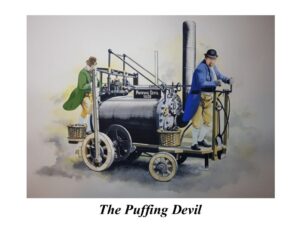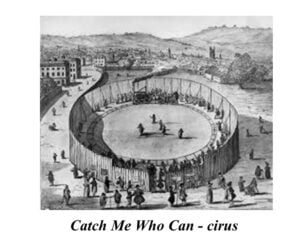
Have you heard of Richard Trevithick?
Richard Trevithick built the first self-propelling steam locomotive that at the Penydarren Ironworks, in Merthyr Tydfil, Wales, which made the first locomotive-hauled railway journey.
I bet you have never heard of him. You will have heard of Robert Stephenson and his rocket, but that wasn’t until 1829, he wasn’t the first, Richard Trevithick was 25years earlier!
So, who was this forgotten man? Well, he was from Cornwall, was a mining engineer, and had been immersed in mining and engineering all his life.
The bit I like about him is that he didn’t like school and kept finding various ways to get out of school. Except he had a weird view of maths. He loved it, and frustrated his teacher by always arriving at the right answers by unconventional routes! This meant that his teachers described him as a disobedient, slow, obstinate, spoiled boy, frequently absent and very inattentive, I don’t think they liked him.
As a child he watched steam engines pump water from the deep tin and copper mines in Cornwall.
Trevithick first went to work at the age of 19 in a Mine. He was enthusiastic and quickly gained the status of a consultant, unusual for such a young person.
Then in 1797 he married Jane Harvey of Hayle. Jane’s father, John Harvey, had a company that became famous worldwide for building huge stationary “beam” engines for pumping water, usually from mines.
Trevithick became an engineer in another mine in 1797, and there he worked out a way to use high-pressure steam. His aim was to find a way to avoid the royalties that were due to Watt on the separate condenser patent. It didn’t work and Boulton & Watt served an injunction on him at the Ding Dong mine in Penwith, Cornwall.
In all this he realised that enough steam could be generated to move a piston up and down, it was called “strong steam”.
He was not the first to think of so-called “strong steam”. William Murdoch, his next-door neighbour, had demonstrated it to him in 1784.
By 1799 Trevithick had made it work, then he began building models of high-pressure steam engines. Initially a stationary one, then subsequently one attached to a road carriage.
Puffing Devil
 Trevithick then went and took the next step. In 1801 he built a real working steam road locomotive, that he called The Puffing Devil.
Trevithick then went and took the next step. In 1801 he built a real working steam road locomotive, that he called The Puffing Devil.
On Christmas Eve that year, he demonstrated it by taking six passengers from Cambourne to the nearby village of Beacon. Did you know that this trip became the inspiration for the popular Cornish folk song “Camborne Hill”?
Now here is a funny story, as it appears three days later it broke down. Well, there was only one thing to do, wasn’t there, go to the pub! There they had a good meal of roast goose, along, naturally, with a drink or two.
They totally forgot about The Puffing Devil. Meanwhile, its water started to boil, the engine over heated and then the machine caught fire and was destroyed. Now here is the interesting bit, Trevithick wasn’t too worried about this, he just put it all down to operator error!
“Pen-y-Darren” locomotive
In 1802 Trevithick built one of his high-pressure steam engines at the Pen-y-Darren Ironworks in Merthyr Tydfil, Mid Glamorgan. With the assistance of an employee of the iron works and under the supervision of Samuel Homfray, the proprietor, he mounted the engine on wheels and turned it into a locomotive.
Now at this point the owner thought this was really impressive, and he made a 500 Guineas bet with another ironmaster. It was that the locomotive could haul 10 tonnes of iron along rails along the Merthyr Tydfil Tramroad from Penydarren to Abercynon, 9.75 miles
Everyone was interested, so on the 21st of February 1804 it carried 10 tonnes of iron, 5 waggons and 70 men the full distance. It took them 4 hours 5 minutes, which meant that it moved at an average speed of 2.4 mph.
The result was that Trevithick had shown that provided it was a gentle gradient you could move heavy carriages along an iron road with the steam engine.
Catch Me Who Can – Trevithick’s steam circus
“ ” was Trevithick’s way of showing the world that a steam locomotive could pull passengers. So, with the help of others he built a circus in the centre of London. It was in the round with three locomotives, the idea was that people paid to go on a train.
” was Trevithick’s way of showing the world that a steam locomotive could pull passengers. So, with the help of others he built a circus in the centre of London. It was in the round with three locomotives, the idea was that people paid to go on a train.
Another history fact, it was the first ever fare paying train. Unfortunately, it was a financial disaster. The result was that Trevithick lost interest in trains and steam engines after this.
However, he was an interesting man who we never hear about, who was always arriving at the right answers by unconventional routes.
Isn’t history interesting?
10 questions to discuss:
- Education: Although described as disobedient and inattentive, what did Richard Trevithick excel at in school?
- Early Inspiration: Before working in mines, what sparked Trevithick’s interest in steam engines?
- High-Pressure Steam: What motivated Trevithick to develop high-pressure steam engines despite legal complications?
- Puffing Devil: Were there any safety concerns or setbacks during the first demonstration of the “Puffing Devil”?
- Pen-y-Darren Locomotive: What motivated the bet involving the Pen-y-Darren locomotive, and what were the stakes?
- Impact of the Pen-y-Darren Locomotive: How did the successful journey at Pen-y-Darren contribute to the development of locomotives?
- Catch Me Who Can: What were the key features and purpose of Trevithick’s “steam circus” in London?
- Financial Struggles: Why did the “Catch Me Who Can” project ultimately lead to Trevithick losing interest in steam engines?
- Legacy: Despite financial struggles, how did Richard Trevithick contribute to the advancement of locomotive technology?
- Forgotten Figure: Why do you think Richard Trevithick and his achievements are often overshadowed by later figures like Robert Stephenson?
These questions are to encourage discussion and deeper understanding of various aspects of Trevithick’s life and inventions. They delve into his motivations, challenges, successes, and impacts on the field of locomotives.
For more about this fascinating man:
https://www.asme.org/topics-resources/content/richard-trevithick
https://museum.wales/articles/1012/Richard-Trevithickrsquos-steam-locomotive/
http://www.trainhistory.net/train-invention/richard-trevithick/
© Tony Dalton

